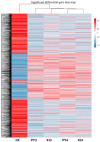Transcriptome Analysis of Kiwifruit in Response to Pseudomonas syringae pv. actinidiae Infection
- PMID: 29373527
- PMCID: PMC5855595
- DOI: 10.3390/ijms19020373
Transcriptome Analysis of Kiwifruit in Response to Pseudomonas syringae pv. actinidiae Infection
Abstract
Kiwifruit bacterial canker caused by Pseudomonas syringae pv. actinidiae (Psa) has brought about a severe threat to the kiwifruit industry worldwide since its first outbreak in 2008. Studies on other pathovars of P. syringae are revealing the pathogenesis of these pathogens, but little about the mechanism of kiwifruit bacterial canker is known. In order to explore the species-specific interaction between Psa and kiwifruit, we analyzed the transcriptomic profile of kiwifruit infected by Psa. After 48 h, 8255 differentially expressed genes were identified, including those involved in metabolic process, secondary metabolites metabolism and plant response to stress. Genes related to biosynthesis of terpens were obviously regulated, indicating terpens may play roles in suppressing the growth of Psa. We identified 283 differentially expressed resistant genes, of which most U-box domain containing genes were obviously up regulated. Expression of genes involved in plant immunity was detected and some key genes showed differential expression. Our results suggest that Psa induced defense response of kiwifruit, including PAMP (pathogen/microbe-associated molecular patterns)-triggered immunity, effector-triggered immunity and hypersensitive response. Metabolic process was adjusted to adapt to these responses and production of secondary metabolites may be altered to suppress the growth of Psa.
Keywords: Psa; bacterial canker; kiwifruit; resistance.
Conflict of interest statement
The authors declare no conflict of interest.
Figures



Similar articles
-
Whole transcriptome sequencing of Pseudomonas syringae pv. actinidiae-infected kiwifruit plants reveals species-specific interaction between long non-coding RNA and coding genes.Sci Rep. 2017 Jul 7;7(1):4910. doi: 10.1038/s41598-017-05377-y. Sci Rep. 2017. PMID: 28687784 Free PMC article.
-
The flavonoid metabolic pathway genes Ac4CL1, Ac4CL3 and AcHCT1 positively regulate the kiwifruit immune response to Pseudomonas syringae pv. actinidiae.Plant Mol Biol. 2025 Jan 17;115(1):21. doi: 10.1007/s11103-024-01546-6. Plant Mol Biol. 2025. PMID: 39821123
-
LACCASE35 enhances lignification and resistance against Pseudomonas syringae pv. actinidiae infection in kiwifruit.Plant Physiol. 2025 Feb 7;197(2):kiaf040. doi: 10.1093/plphys/kiaf040. Plant Physiol. 2025. PMID: 39854627
-
The Scientific, Economic, and Social Impacts of the New Zealand Outbreak of Bacterial Canker of Kiwifruit (Pseudomonas syringae pv. actinidiae).Annu Rev Phytopathol. 2017 Aug 4;55:377-399. doi: 10.1146/annurev-phyto-080516-035530. Epub 2017 Jun 14. Annu Rev Phytopathol. 2017. PMID: 28613977 Review.
-
Kiwifruit bacterial canker: an integrative view focused on biocontrol strategies.Planta. 2021 Jan 27;253(2):49. doi: 10.1007/s00425-020-03549-1. Planta. 2021. PMID: 33502587 Review.
Cited by
-
Early Pathogen Recognition and Antioxidant System Activation Contributes to Actinidia arguta Tolerance Against Pseudomonas syringae Pathovars actinidiae and actinidifoliorum.Front Plant Sci. 2020 Jul 22;11:1022. doi: 10.3389/fpls.2020.01022. eCollection 2020. Front Plant Sci. 2020. PMID: 32793252 Free PMC article.
-
Design, synthesis, crystal structure, and in vitro antibacterial activities of sulfonamide derivatives bearing the 4-aminoquinazoline moiety.Mol Divers. 2023 Jun;27(3):1243-1254. doi: 10.1007/s11030-022-10484-8. Epub 2022 Jul 2. Mol Divers. 2023. PMID: 35779170
-
E3 Ubiquitin Ligase PUB23 in Kiwifruit Interacts with Trihelix Transcription Factor GT1 and Negatively Regulates Immune Responses against Pseudomonas syringae pv. actinidiae.Int J Mol Sci. 2024 Feb 5;25(3):1930. doi: 10.3390/ijms25031930. Int J Mol Sci. 2024. PMID: 38339209 Free PMC article.
-
Plant⁻Microbe Interaction 2017-The Good, the Bad and the Diverse.Int J Mol Sci. 2018 May 5;19(5):1374. doi: 10.3390/ijms19051374. Int J Mol Sci. 2018. PMID: 29734724 Free PMC article.
-
BSR-Seq analysis provides insights into the cold stress response of Actinidia arguta F1 populations.BMC Genomics. 2021 Jan 22;22(1):72. doi: 10.1186/s12864-021-07369-9. BMC Genomics. 2021. PMID: 33482717 Free PMC article.
References
-
- Serizawa S., Ichikawa T., Takikawa Y., Tsuyumu S., Goto M. Occurrence of bacterial canker of kiwifruit in Japan, description of symptoms, isolation of the pathogen and screening of bacteriocides. Jpn. J. Phytopathol. 1989;55:427–436. doi: 10.3186/jjphytopath.55.427. - DOI
MeSH terms
Substances
LinkOut - more resources
Full Text Sources
Other Literature Sources
Research Materials
Miscellaneous

